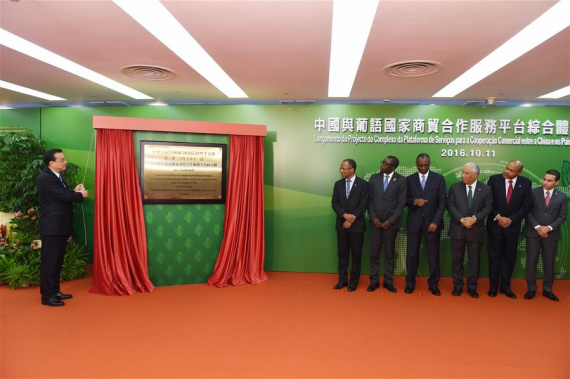
Chinese Premier Li Keqiang (1st L) attends the launch ceremony for a complex for the China-PSCs cooperation platform before the opening ceremony of the 5th Ministerial Conference of the Forum for Economic and Trade Cooperation between China and Portuguese-speaking countries (PSCs), in Macao, south China, Oct. 11, 2016.(Photo: Xinhua/Rao Aimin)
Overall, the Chinese economy this year, especially in the third quarter, has performed better than what we expected. Employment, in particular, has remained basically stable. Each year in the past three years, more than 13 million new urban jobs were created. In the first nine months of this year, the number stood at 10.67 million, maintaining this rate of job creation. In September, the surveyed urban unemployment rate in 31 big cities fell below 5 percent, the first time in recent years. For China, a big developing country of more than 1.3 billion people, employment is of primary importance. The main purpose of growth, after all, is to ensure job creation and improve people's well-being.
Having said all this, we should not lose sight of the downward pressure the Chinese economy still faces. To keep the economy stable, we need to not only maintain aggregate demand, but also speed up supply-side structural reform to improve the quality and efficiency of the supply system. Now, there is certain talk about risks in China's debts and the property market. These issues should be viewed objectively and put into perspective. The debt risk in China is controllable overall. The main problem now is unbalanced debt structure. China's government debt ratio is relatively low among major economies with merely 16 percent for the central government. Though the ratio at the local levels is higher,borrowing by local governments is getting better regulated, and used mainly for development, rather than welfare handouts. Most debts are asset-backed and generate returns. The problem with leverage mainly lies in relatively high leverage ratio in non-financial companies. This is closely related to fledgling and not mature state of China's capital market, high propensity to save with the savings rate above 50 percent, and a financing structure with banks in a predominant position. China's debts are mostly internal and the share of external debts is low. Hence the likelihood of debt risk is also small. Our monetary policy is prudent, ensuring reasonably sufficient liquidity. And the commercial banks have high capital adequacy ratio and provision coverage ratio. Their non-performing assets ratio, despite some increase, is far below the world's average. They have strong ability of risk compensation and loss absorption. Going forward, we will gradually bring down non-financial corporate leverage ratio and address hidden risks by developing multi-tiered capital markets, raising the share of direct financing and promoting corporate mergers and restructuring.
Talking about the property market, China's new type of urbanization will be a long process. Given the trend of divergence in the housing market, we will urge local governments to shoulder their responsibilities and adopt city-specific policies to meet people's basic housing needs and take effective measures that suit national and local conditions, endeavor to provide housing to all in need and ensure steady and sound development of the real estate market. We are confident that we will be able to meet the major economic and social development targets this year, forestall systemic and regional financial risks, and lay a solid foundation for stable development next year.
Over the past few years, the Chinese economy has withstood internal and external pressures and achieved steady progress and better quality. This is not done by resorting to massive stimulus. Instead, it is because of our commitment to reform and opening up and our efforts to push for innovative macro regulation, supply-side structural reform and faster shift of growth drivers. We have been streamlining administration, delegating power, strengthening regulation, and improving government services. We have been vigorously implementing the innovation-driven development strategy to boost mass entrepreneurship and innovation. Since last year, there have been more than 40,000 new entities entering the market every day, among which 12,000 are newly-registered companies. From January to August this year, the number of newly-registered companies per day reached 15,000. New technologies, new industries and new business models are growing at a faster pace and many traditional industries are coming back to life. New growth drivers are rising, traditional growth drivers are being upgraded, and the quality of growth is improving. All this has shown enormous creativity in the market and the society. Looking ahead, with big potential, solid advantages and broad maneuvering room, the Chinese economy is well prepared to achieve medium-high growth rates and advance to medium-high development levels.
China's tremendous development in the past would not have been possible without opening-up. China will remain firmly committed to the win-win strategy of opening-up, and the door will open wider. China is committed to cultivating new drivers of growth and promoting transformation and upgrading of its economy. This is a process of self-improvement and also an opportunity for the world as it represents enormous investment opportunities and market potential. It is expected that in the next five years, China's total imports will reach 8 trillion U.S. dollars, total outbound investment will reach 720 billion U.S. dollars and the Chinese will make over 600 million outbound visits. All this will bring huge business opportunities to companies of all countries, including Portuguese-speaking countries.
Ladies and Gentlemen,
As a Portuguese saying goes, "true friends are forever" (Os amigos verdadeiros sao para sempre). We Chinese also say that as distance tests a horse's strength, time reveals a person's heart. Time has shown and will continue to show that China and Portuguese-speaking countries are good friends and close partners who can trust and count on each other. Let's pool our strengths and wisdom together, ride the waves and steer forward the ship of amity and cooperation between China and Portuguese-speaking countries.
Thank you.


















































